�
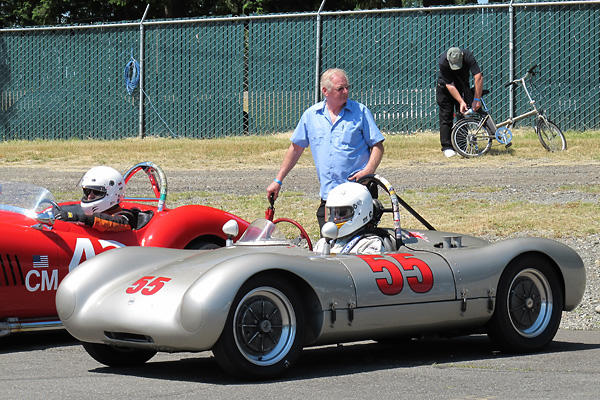
�
Cameron Healy's Cooper-Porsche ("Pooper") Racecar
� ��
Owner: Cameron Healy
�
City: Portland Oregon
�
Model: Cooper Mark VII (circa 1953, rebodied in 1954)
�
Engine: 1720cc Porsche four cylinder�
�
Development of the Cooper "500" Chassis
��
John Cooper returned from service in the Royal Air Force and joined his father Charles in�
business. The business was Cooper's Garage of Surbiton, a southwest London suburb.�
As a diversion, John and his friend Eric Brandon decided to build a pair of racecars.�
The announcement of a brand new 500cc Formula racing class gave them an immediate and�
practical objective. Those first two cars were successful. With Charles' help and�
facilities, the two friends continued building racecars, and year after year the Coopers�
made countless incremental technical improvements as they advanced to the top rung of�
the sport. Ultimately, the Cooper Car Company would produce two Formula One World�
Championship winning racecars.�
�
The premise of 500cc racing was that racecars could be economically built around�
motorcycle engines. "JAP" (J. A. Prestwich) single cylinder engines were most popular. �
However, only about a dozen Cooper racecars were built before a customer special-ordered�
a slightly longer chassis to accommodate a 1000cc JAP V-twin engine. From 1949, Coopers�
were offered in short and long versions, for 500cc and 1000cc competition respectively.�
�
In November 1949 the FIA announced creation of a new class of international racing �
which would adopt essentially intact the British 500cc club's rules. It would be called �
"Formula 3". Effective immediately, the market for Cooper Car Company's products expanded�
throughout Europe. Cooper company records show six of their MkV cars were shipped to U.S.A.�
in 1951. (Cooper's 1952 and 1953 records are largely missing.) SCCA records show Cooper F3�
cars competing occasionally in 1952 and 1953. In 1954 there were enough F3 cars that SCCA�
awarded a national championship trophy to a Mr. Harry Whitney of Pennsylvania. Alexis�
duPont and Rowland Keith tied in points for second. All three drove Coopers.�
�
Generally, the Cooper Car Company redesigned its Formula 3 cars annually. For 1951, �
body panels were streamlined and made completely detachable, though upper panels were�
mounted on hinges for convenient access. In 1951, Cooper also created a "special" of�
their own with streamlined body for record attempts. In 1952, Cooper abandoned box�
section, ladder frames in favor of upper and lower longitudinal chassis tubes of 1.5"�
diameter with perforated sheetmetal vertical braces between tubes. The Mk7 model�
of 1953 featured relatively minor updates, including improved shock absorbers and a�
lower-mounted steering rack.�
�
�
 �
�
�
�
Three Particular Chassis Features
��
Much has been written about John Cooper's decision to put engines behind drivers.�
Originally, the main reason to do this was that it simplified power transmission,�
especially since chain-drives were being utilized on the earliest Cooper cars. The�
mid-engine format also facilitated reduced weight and decreased frontal area. Once�
Cooper went that way, there was no reason to turn back! �
�
Another characteristic Cooper design feature was transverse leafsprings. The�
first Cooper 500cc cars utilized Fiat 500 Topolino (1936-1955) suspension components.�
On the Topolino, a transverse leafspring was used for the front suspension only.�
John Cooper reasoned that the same spring could be used for both front and rear.�
As on the Fiat, leafsprings served to locate the upper ends of Cooper's hub carriers.�
This approach was used through 1957, even as Cooper dominated the new "Formula Two"�
racing class by winning eight out of ten of the major races. Finally in 1958, when �
Cooper began contesting Formula One races, they developed a dual wishbone coilover �
front suspension and at the rear they supplemented the transverse leaf spring with �
upper wishbones for more precise handling. �
�
Cast wheels with integral brake drums are a third distinctive and notable feature�
of early Cooper cars. The concept had previously been employed by Bugatti, at least�
as early as 1924. From 1948, Cooper's earliest bespoke wheels were cast from�
aluminum alloy. Starting in 1949, Cooper used and offered customers similar wheels�
except made of extra-light Elektron™ magnesium alloy. (The weight�
advantage of magnesium would have been at least 20% and thus over 3#/wheel, depending�
on specific alloys employed.) For lightweight racing classes, integral brake�
drums worked well and were cost effective. Excellent heat transfer away from�
cast-in iron hoops translated into reduced brake fade during longer races. Integral�
brake drums also made the wheels especially rigid and simplified access to brake�
shoes. Studying old photos, it's evident Cooper produced many different wheel designs�
in the 1950s (including multi-component wheels as shown below) but with integral�
brake drums as a common feature until 1958 when Cooper began installing Girling disc�
brakes. At that time, Cooper designed distinctive new 8-spoke alloy wheels with more�
curvature in the hub section to achieve the desired stiffness. Cooper's 8-spoke alloys�
evolved into the ubiquitous Minilite™!�
�
�
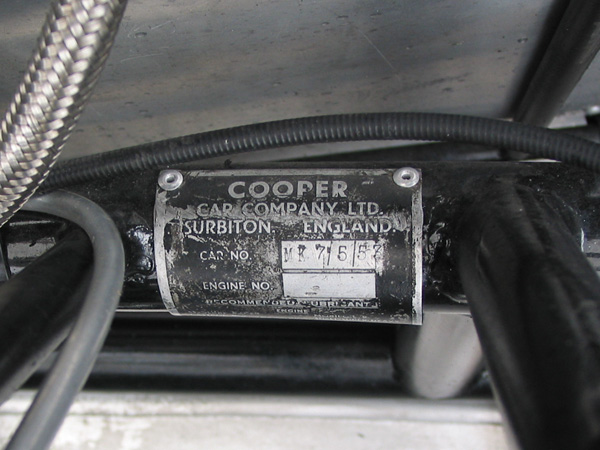
�
COOPER CAR COMPANY LTD. Surbiton. England.
�
CAR NO. Mk7/5/53, ENGINE NO. (blank)
�
RECOMMENDED LUBRICANTS
�
ENGINE: Essolube Racer, Mobil Oil R, Castrol R, Shell Super Heavy, Price's Energol Racing
�
GEARBOX: Essolube 50, Mobil Oil R, Castrol Grand Prix, Golden Shell, Price's Energol SAE 60
�
A Race to Build the first Cooper-Porsche
��
The fifth Cooper Mk7 produced was purchased by an American customer named Gordon "Tippy" Lipe.�
(Note: Lipe rhymes with "stripe".)�
Lipe raced his 500cc Cooper at least once; he used it to win a first-in-class trophy at the�
Giant's Despair hillclimb in Wilkes-Barre PA on July 24, 1953. We find no other race results�
for Lipe in 1953. As far as we know, he may have come home from Pennsylvania and immediately�
started working on re-powering his Cooper with a Porsche 1500cc engine. In this, he was�
assisted by Robert Harbinson and by Bill Lloyd, a cousin of Briggs Cunningham. Interestingly,�
Briggs Cunningham was SCCA's current (1953) national champion in the F-Modified class, which�
is the very same class Lipe evidently intended to contest. Bill Lloyd operated an auto body�
shop in Westport Connecticut, and also enthusiastically raced a Ferrari in D-Modified. �
�
The name Gordon C. Lipe appears in official race results from the Florida National Sports�
Car Races held at MacDill Air Force Base on January 31, 1954. Specifically, in the Imperial�
Polk County Trophy Race (50 miles, for all Modified cars under 1500cc) he is listed as having�
driven a Porsche to 5th place overall and also fifth place in the F-Modified (1000-1500cc)�
class. In the Governor Dan McCarty Memorial Trophy Race (200 miles, all classes) Lipe won a�
trophy for 3rd place in F-Modified. Although the official race results are slightly ambiguous,�
we firmly believe Lipe was still driving a Porsche chassis at McDill. �
�
The first specific reference to a "Cooper-Porsche" that we find in published literature�
is in a photo caption from coverage of the 1954 Giant's Despair hillclimb which was held�
July 22-24, 1954. Is this a different Cooper-Porsche? We've found no other record of�
"Lyeth" or his racecar. (See photo.)�
�
�
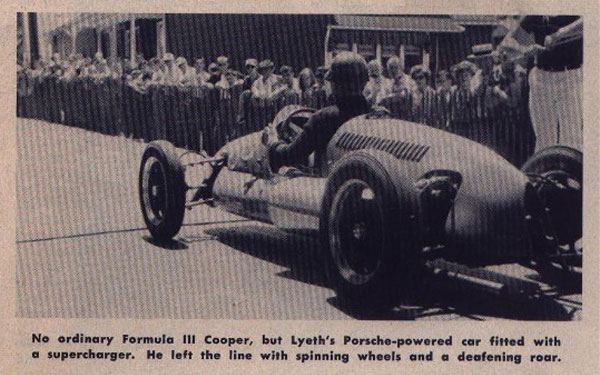
�
(From the 1954 Giant's Despair hillclimb race report. Photo by Ozzie Lyons.)
�
�
Another much better known Cooper-Porsche was built and very successfully raced by Pete Lovely.�
"The Lovely Pooper" with which Pete Lovely won SCCA's 1955 F-Modified national championship,�
certainly deserves its own article. We don't have sufficient photos or information to do it�
justice here. Suffice it to say that Mr. Lovely arranged to buy an aluminum-bodied "streamliner"�
from Cooper and then set about installing a Porsche engine into its MkVIII(R) chassis.�
Now owned by Denny Aker of Seattle, the ex-Lovely Cooper-Porsche is still vintage raced to�
this day, and occasionally races with Cameron Healy's ex-Lipe Cooper-Porsche.�
�
Please support the sponsoring companies who make www.BritishRaceCar.com possible, including:
� �
 �
�
�
�
�
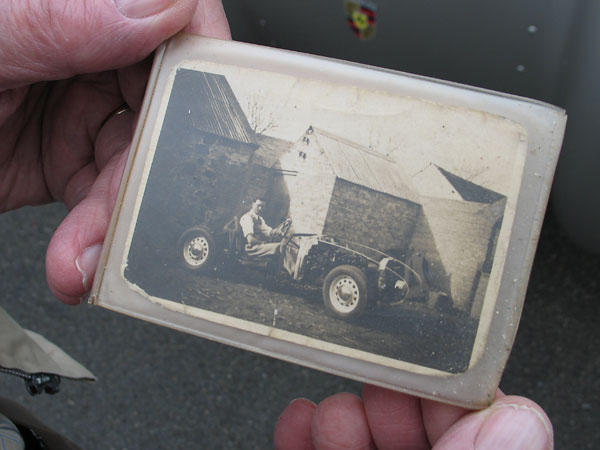
�
In process: Robert Harbinson's own sports car which he built in 1951 before leaving Northern Ireland.
�
(Robert Harbinson showed us his original snapshots when we visited with him at Watkins Glen in 2009.)
�
Robert Harbinson's Custom Aluminum Bodywork
��
In 1951, shortly after completing training to become a Certified Welder, Robert Harbinson�
built a one-off aluminum sports car body and installed it on a Singer Nine Bantam chassis.�
A compact radiator was sourced from Bobby Baird which allowed Harbinson to keep the bonnet�
line low. That first Singer Special was only ever intended for personal recreational use.�
The satisfaction of building the car and the fabrication skills honed would stay with�
Harbinson long after he left his home to "see the world".�
�
In early 1954 Harbinson bought a one-way ticket to New York City and made plans to continue�
from there to Minneapolis. No one seems to know what happened to the Harbinson Special, but�
it was featured in the January 1954 issue of Britain's venerable MotorSport magazine. That�
brief article reached New York City before Harbinson did. Shortly after he landed, Tippy Lipe�
tracked down Harbinson and offered him a commission to build a second sports car body.�
Minneapolis would have to wait! �
�
Per Lipe's instructions, Harbinson created a body specifically designed to meet the letter�
of SCCA rules for the Modified sports car classes. For this reason, it was originally�
equipped with a passenger seat, lights, horn, etc.�
�
�
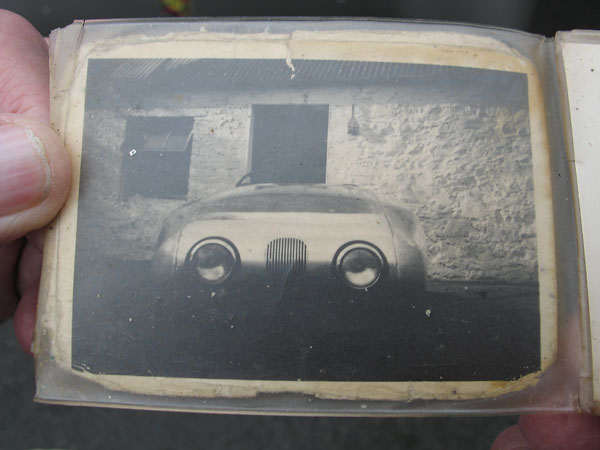
�
Self taught in the art of metal forming, Robert Harbinson built his first aluminum car body with hand tools
�
in lieu of specialized machinery such as English wheels, motorized planishing hammers, etc.
�
Racing History of the Tippy Lipe "Pooper"
��
The first unambiguous mentions of Tippy Lipe's Cooper-Porsche we could find in SCCA race�
results are from the September 5, 1954 meeting at Thompson Raceway in Connecticut. In the�
Unrestricted class race Lipe's Cooper-Porsche took the lead immediately but retired early�
with brake failure. (Ensley in a Kurtis came back from running eighth to steal victory from�
Cade in a Maserati-Chrysler.)�
�
Soon behind Thompson came the September 17-18, 1954 Watkins Glen Grand Prix weekend. In the race�
program, Gordon C. Lipe of Fayetteville NY is listed as having entered a 1486cc Cooper.�
Sports Illustrated magazine mentioned Lipe's Cooper-Porsche in their report:�
"In the Seneca Cup (11 laps, 50.6 miles for unrestricted cars and sports cars of all classes)�
the favorite among 34 starters was Gordon 'Tippy' Lipe whose temperamental, supercharged�
Porsche-Cooper can outaccelerate almost anything. Lipe got clean away from the field for�
two laps, pursued by Phil Cade in a veteran Maserati, and by that phlegmatic sportsman,�
Dr. M. R. J. Wyllie with a C-Type Jaguar. However, the Cooper-Porsche lost its verve�
after two laps and quit on the fourth. Wyllie took the lead on lap 3 and held it to the�
checkered flag. Paul Timmins was second in his Hansgen-Jaguar Special, and Alan Patterson II�
placed third with an Allard. Wyllie averaged 76.2 mph."�
�
Tippy Lipe's greatest success with the Pooper came on May 15, 1955 at Cumberland, Md. where�
he won first place over a tough field of F, G and H Modified cars which included a works�
Porsche 550 Spyder driven by Herbert Linge. Lipe finished first in class and sixth overall�
in the Mt. Equinox (Vermont) hillclimb, held on June 19. On July 4th at Beverly Massachusetts�
in The Tea Party Trophy Race, ALL the modified classes ran together; Phil Hill won the overall�
victory in his Ferrari but Lipe finished first-in-class with his Pooper. Later that day,�
Lipe won the Clippership Trophy Race outright, over more realistic competition. At Thompson�
Connecticut on September 4, Lipe finished 6th in class. Overall for the year, Lipe finished�
third in a hotly contested SCCA F-Modified national championship points race.�
�
�
IMPORTANT ANNOUNCEMENT
�
BritishRaceCar.com will have to cut back plans for continued growth if we can't find more financial support.
�
If you like what you've found here, and you want to see more, please click here and follow the instructions.
�
Readers like you keep BritishRaceCar.com online and growing through voluntary financial contributions.
�
�
In 1957 Tippy Lipe sold his Cooper Special to Ed Walsh of St Louis, sans engine.�
Knowing that Carroll Shelby was traveling in Italy, Walsh contacted him and asked if�
Shelby would help him to procure an OSCA 750cc engine for the car. With the OSCA engine�
installed, Walsh won the H-Modified (500-750cc) class of SCCA's June Sprints at Road America�
two years in a row (1959 and 1960). In a letter outlining the Pooper's history, Walsh�
described one reaction to the car: "Roger Penske asked me if he could copy it, to which�
I agreed, as he was going to run in a higher class. That was his famous Zerex Special�
that was so successful."�
�
At the end of 1961 Ed Walsh sold the Cooper-OSCA to a racer named Mack Barlow.�
Barlow raced occasionally until 1969, when it was stored in a barn in Wichita, Kansas.�
There it sat, until August 1991 when "Duck" Waddle of Hutchinson Kansas bought the�
car from Virginia Barlow, Mack's widow. Mr. Waddle put the unusual old racecar up�
for sale. In December 1991, John Muller of Kansas City bought the Pooper from Duck.�
John Muller commissioned Brian Haupt of Carriage & Motorworks to restore the car�
to replicate its original configuration. John Muller raced the Pooper extensively�
between 1993 and 1999, at which point he decided to restore it again and then sell it.�
The frame-off restoration was completed in February 2001. In August 2001 Cameron�
Healy of Portland Oregon (founder of the Kettle Foods Inc. potato chip company)�
purchased the car. Healy has raced the Lipe Cooper-Porsche with great enthusiasm and�
success ever since.�
�
Features and Specifications
�| Engine: | �Porsche 1720cc four-cylinder horizontally-opposed engine, built by Cox Racing.�
(Approximately 170hp.)�
SCAT billet crankshaft.�
Carrillo connecting rods.�
40mm stainless steel intake valves.�
Sodium-cooled exhaust valves.�
Dual Solex 40mm twin-choke carburetors with long velocity stacks.�
Bosch distributor (with breaker points).�
Bosch "blue" ignition coil.�
Ultra Hi-Temp Silicone Copper Core spark plug wires.�
Oberg 600 tattle-tale oil filter. | �
| Cooling: | �Setrab 19-row aluminum oil cooler. | �
| Exhaust: | �custom fabricated four-into-one header. | �
| Transaxle: | �original-style Volkswagen 4-speed case, updated with Hewland racing gears. | �
| Chassis: | �85" wheelbase.�
42.5" track width.�
Fully restored and powder-coated frame. | �
| Front Susp.: | �transverse leaf springs.�
Carrera steel bodied shock absorbers.�
Adjustable anti-sway bar.�
Fabricated steel front suspension uprights.�
Cooper proprietary steering rack (magnesium housing). | �
| Rear Susp.: | �transverse leaf springs.�
Carrera steel bodied shock absorbers.�
Cooper proprietary cast magnesium uprights. | �
| Brakes: | �(master) Tilton floor mount pedal assembly, dual master cylinders with remote reservoirs, and remote bias adjuster. � (front) drum brakes, � (rear) drum brakes. | �
| Wheels/Tires: | �15x3.5 hubless wheels bolted around the circumference of Elektron (magnesium) alloy brake drums.�
Dunlop Racing CR48 4.50L-15 (front) and Hoosier Vintage TD 5.00-15 (rear) tires. | �
| Electrical: | �Optima red top battery. | �
| Instruments: | �(left to right)�
Equus coolant temperature gauge (130-280F),�
Racetech oil pressure (0-100psi), and�
VDO tachometer (0-8000rpm).�
| �
| Fuel System: | �authentic replica aluminum fuel tank, with safety bladder built in.�
Holley fuel pressure regulator. | �
| Safety Eqmt: | �Sparco six point cam-lock safety harness.�
Centralized fire suppression system (mounted under passenger seat). | �
| Weight: | �1100 pounds. | �
Engine Installation
��
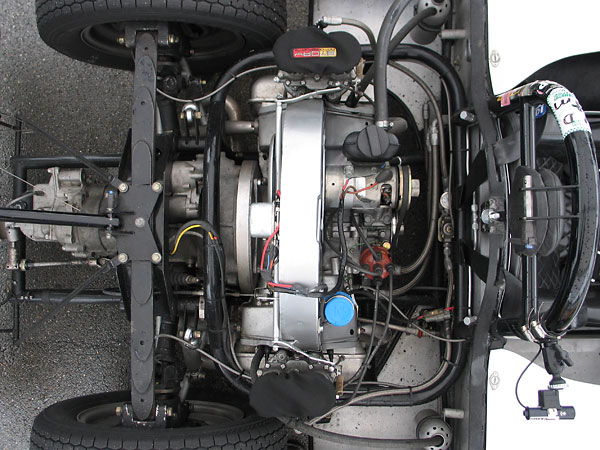
�
Porsche 1720cc four-cylinder horizontally-opposed engine. (Approximately 170hp.)
�
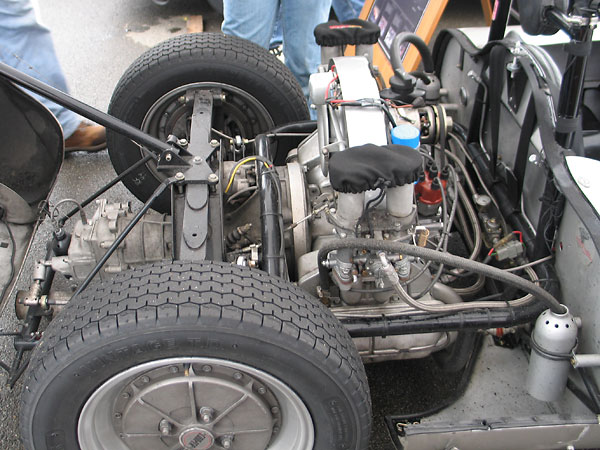
�
Bosch distributor (with breaker points). Bosch "blue" ignition coil.
�
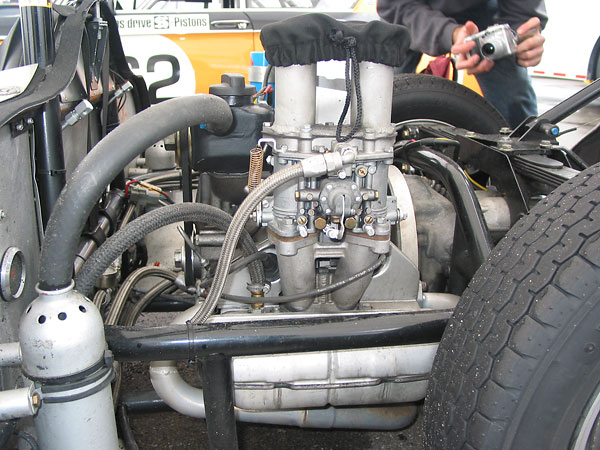
�
One of the engine's two Solex (French made) carburetors.
�
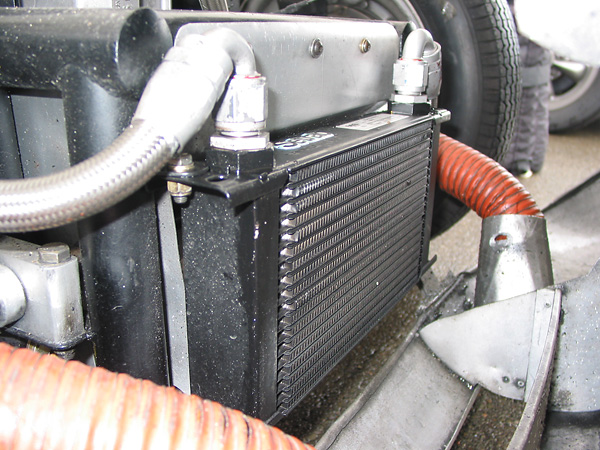
�
Setrab 19-row oil cooler.
�
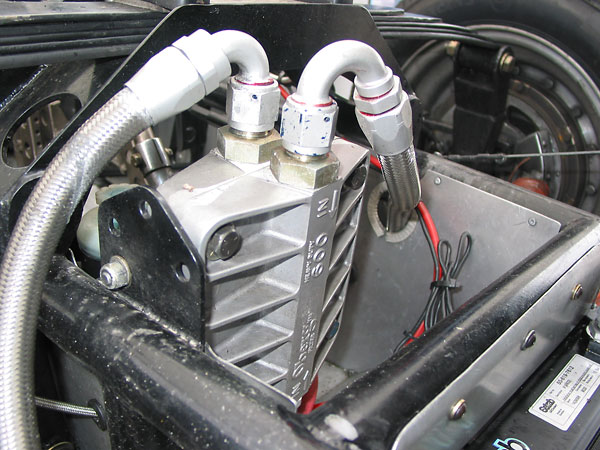
�
Oberg 600 tattle-tale oil filter installed in a relatively inconvenient location for servicing.
�
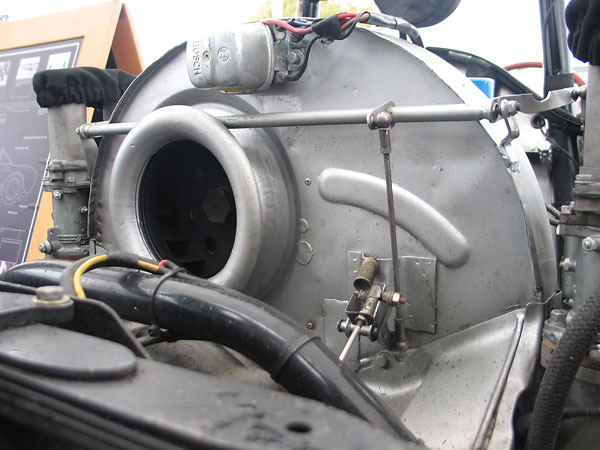
�
Fan shroud: old Porsche and VW engines are air cooled via great big fans.
�
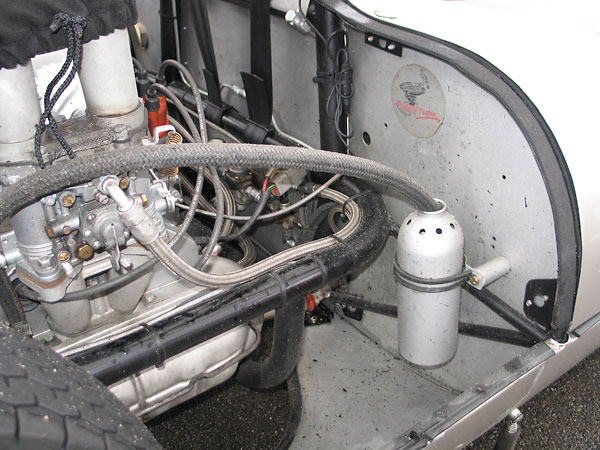
�
Charles Cooper was a big advocate of bent frame tubes.
�
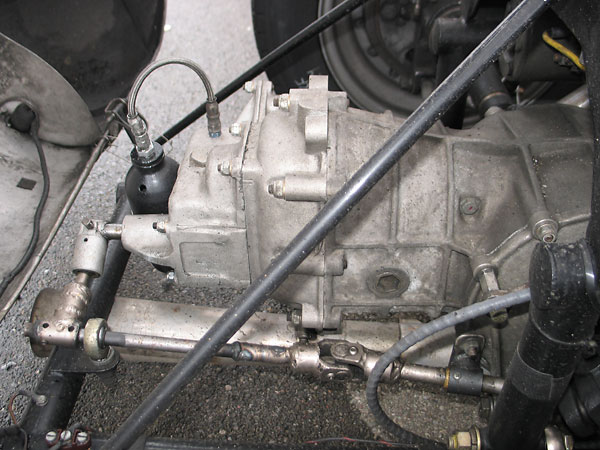
�
Volkswagen 4-speed transaxle with reverse.
�
�
Front Suspension / Etc.
��
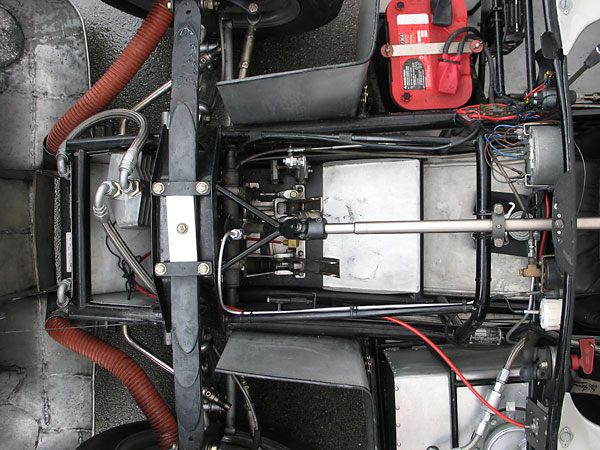
�
A transverse leafspring locates the top of the suspension uprights in three dimensions.
�
Repeated at the rear, this is the trademark feature of 1950's Cooper suspension designs.
�
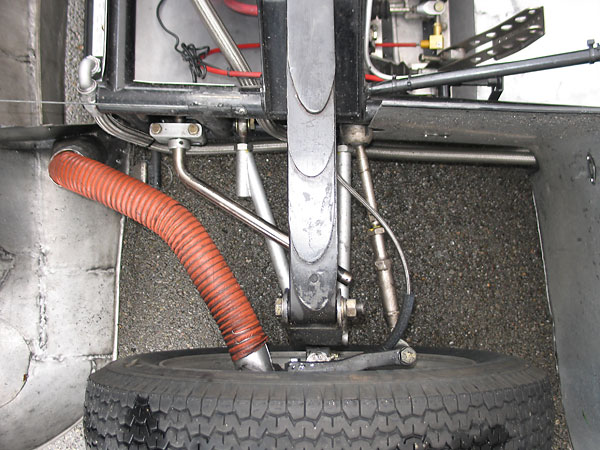
�
It's an unsophisticated and imprecise suspension design, but it served quite well in context:
�
very lightweight but relatively low-powered rear-engined cars shod with tall, narrow tires.
�
Cooper racecars were competitive because they were usually lower and lighter than competitors.
�
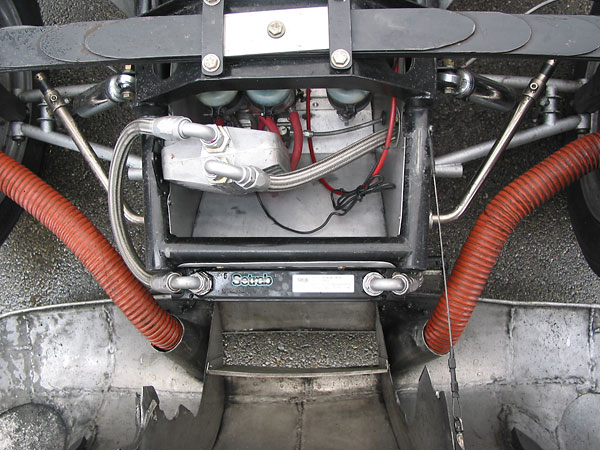
�
With relatively few and large tubes meeting at nearly right angles, Cooper frames were simple
�
to fabricate. On the other hand, they were far heavier than they needed to be. No triangulation
�
anywhere! As Cooper moved into faster racing classes and especially when Lotus cars arrived
�
as competition, Cooper was compelled to produce more sophisticated and elaborate frame designs.
�
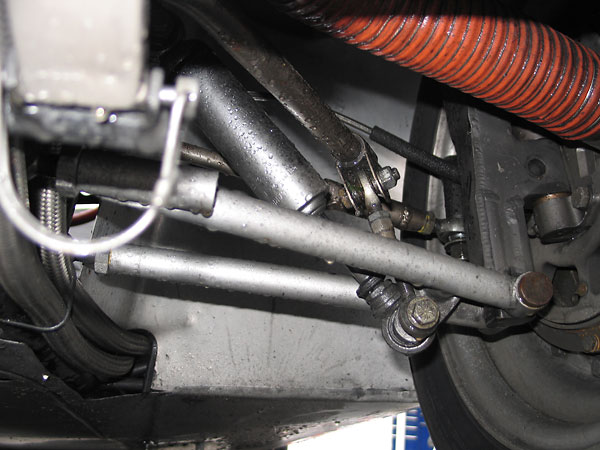
�
Carrera steel bodied shock absorber... layed way over to fit underneath the leafspring.
�
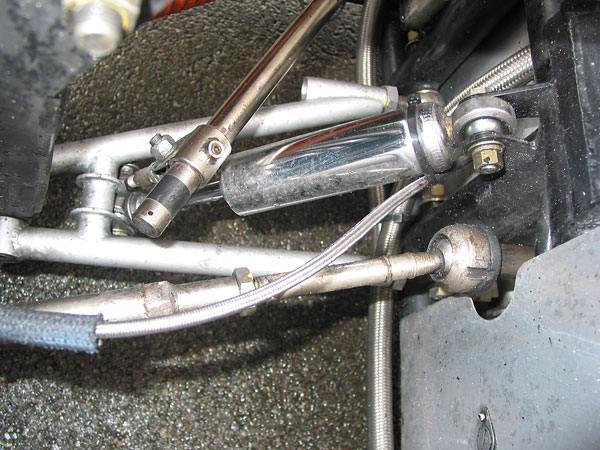
�
Adjustable anti-sway bar.
�
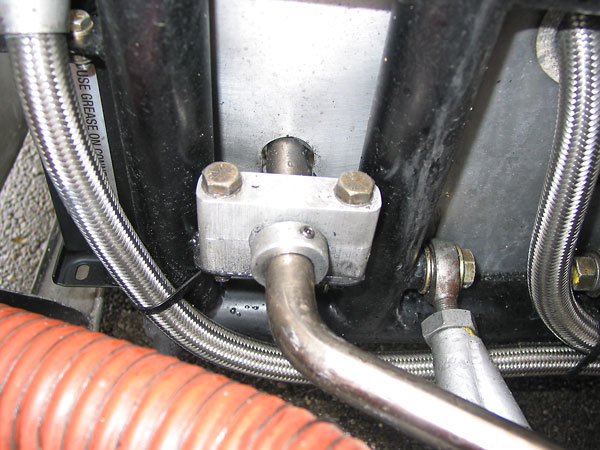
�
The front anti-roll bar attaches to the chassis via these simple aluminum pillow blocks.
�
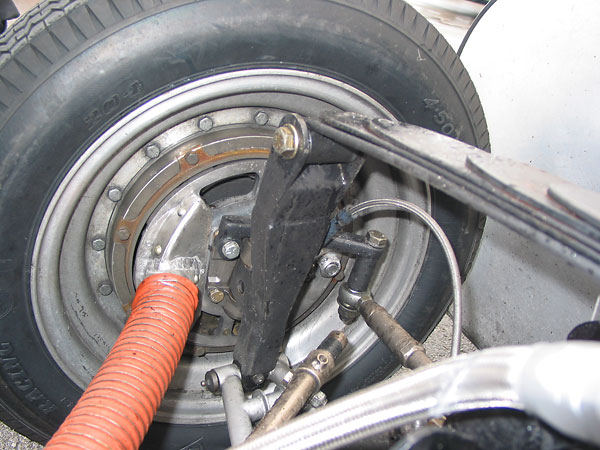
�
Fabricated steel front suspension uprights.
�
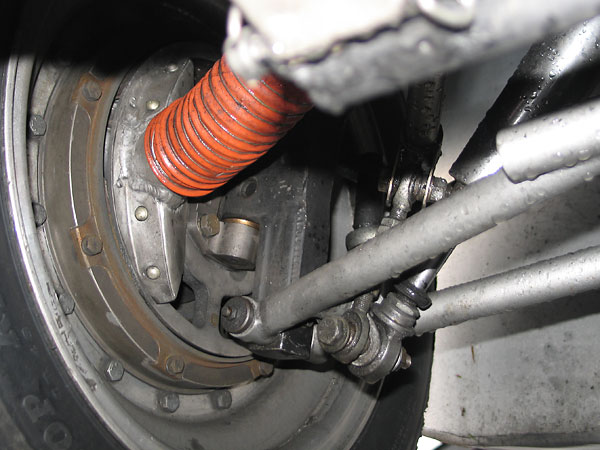
�
Note how disc brake backing plates have been modified to receive cooling airflow. Brakes
�
have always been this car's Achilles heal. Severe brake fade forced Tippy Lipe to retire early
�
from race after race. Apparently later owners have found ways to improve the brakes.
�
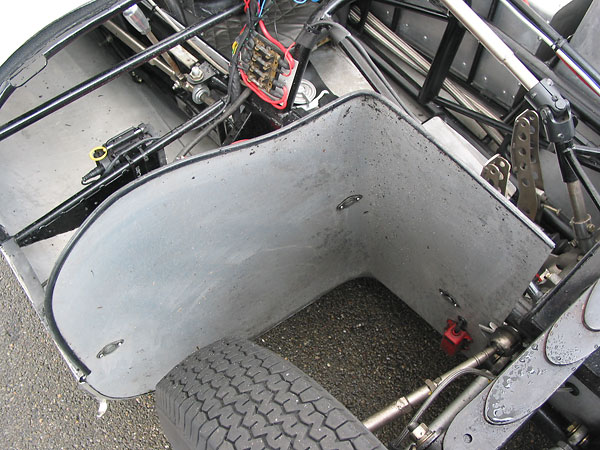
�
Inner fender.
�
�
Enjoying this article? www.BritishRaceCar.com is partially funded through generous support from readers like you!
�
To contribute to our operating budget, please click here and follow the instructions.
�
(Suggested contribution is twenty bucks per year. Feel free to give more!)�
Rear Suspension
��
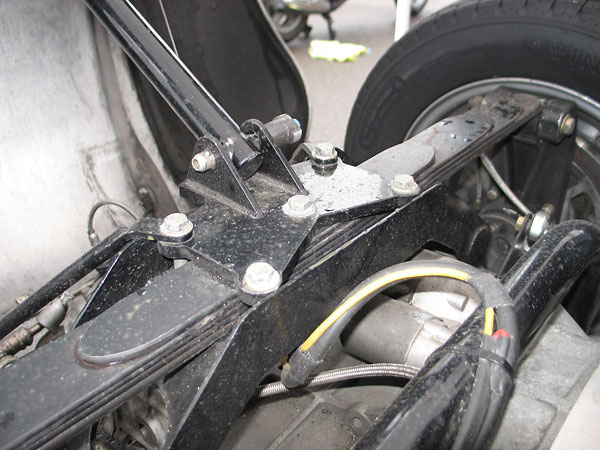
�
A transverse leafspring locates the top of the suspension uprights in three dimensions...
�
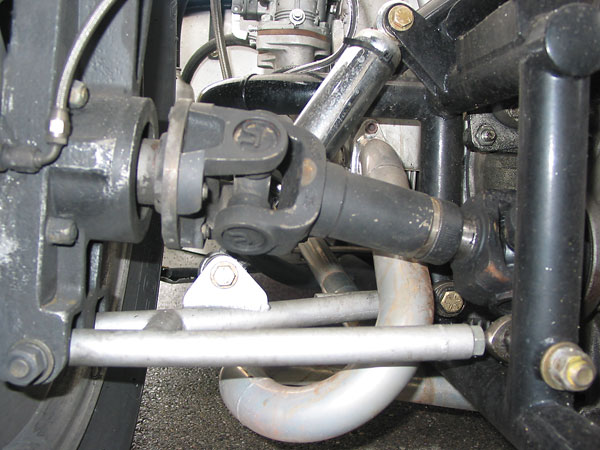
�
Heavy duty halfshafts with a sliding coupling to accomodate plunge.
�
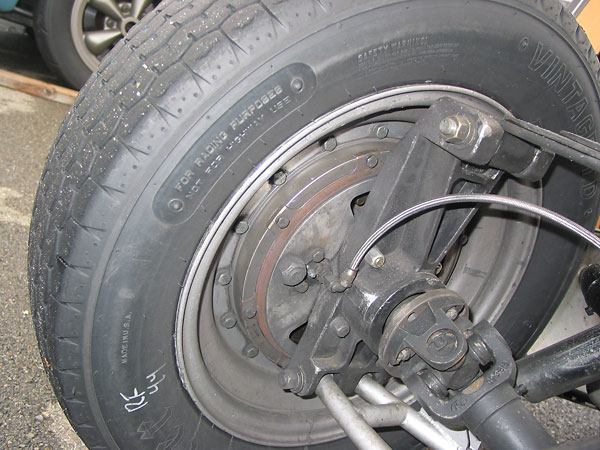
�
Cooper proprietary cast magnesium rear uprights.
�
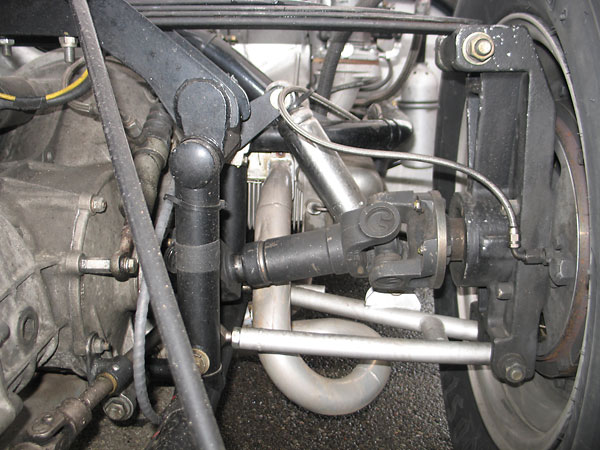
�
Carrera steel-bodied shock absorbers are popular with vintage racers.
�
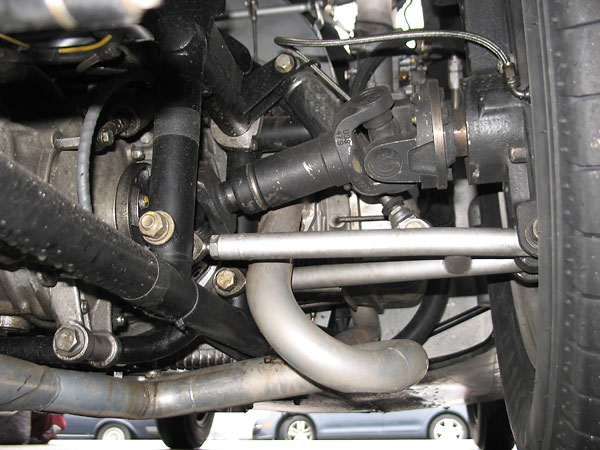
�
Custom four-into-one exhaust header.
�
�
Interior
��
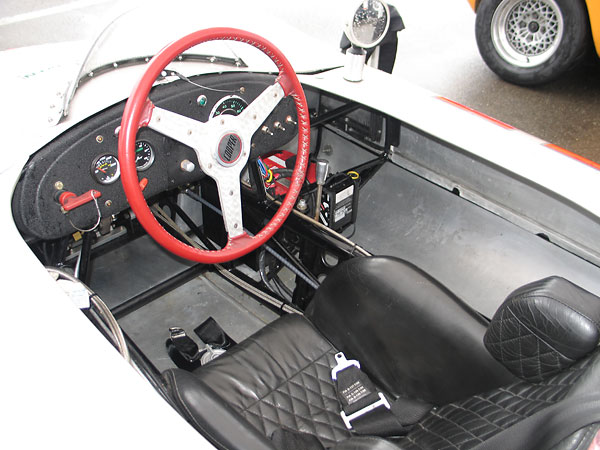
�
Comfy custom seat.
�
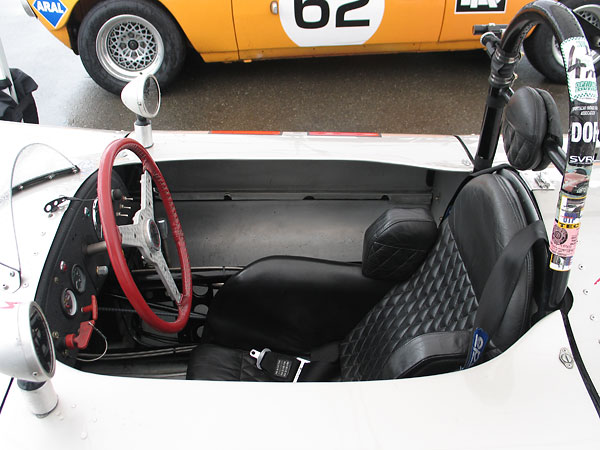
�
Roll hoop tall enough to meet modern height requirements.
�
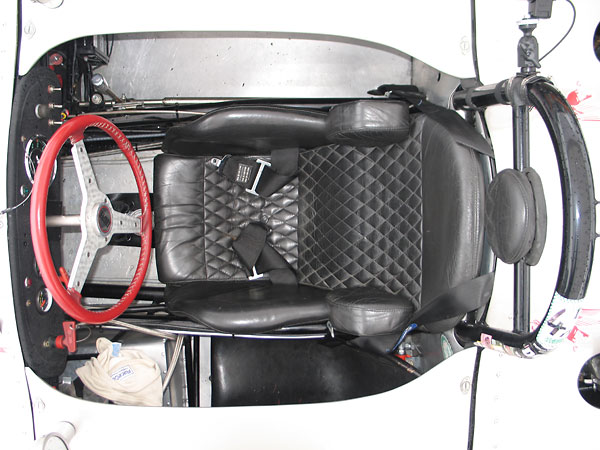
�
Sparco six point cam-lock safety harness.
�
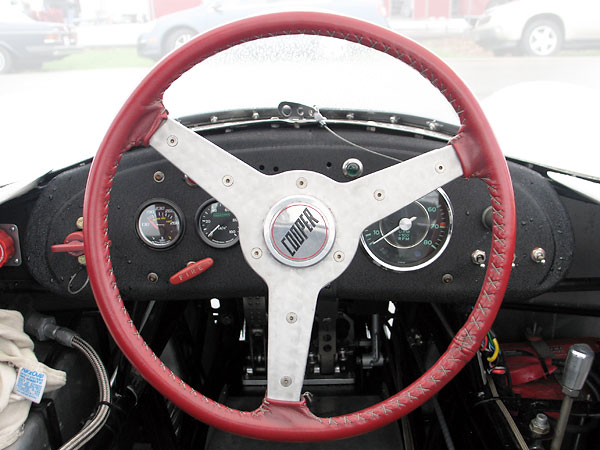
�
Leather wrapped aluminum steering wheel.
�
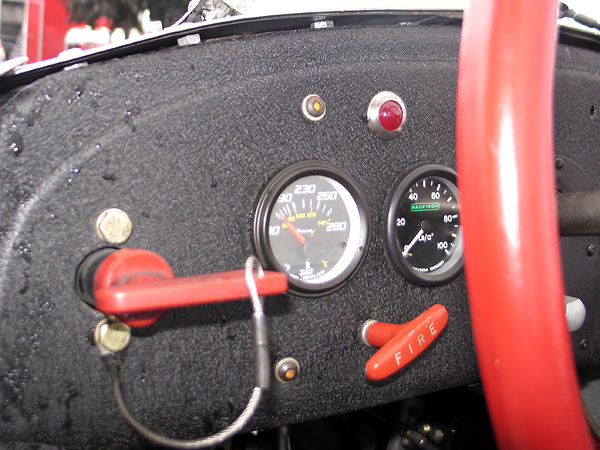
�
Equus coolant temperature gauge (130-280F). Racetech oil pressure (0-100psi) gauge.
�
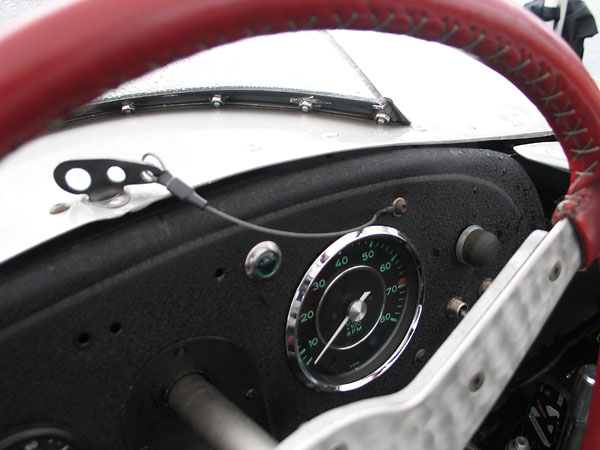
�
VDO tachometer (0-8000rpm).
�
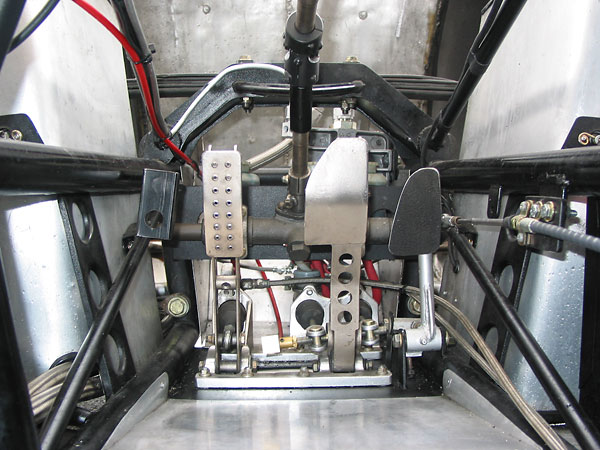
�
Tilton floor-mount, two-pedal pedal assembly. This is an obsolete model, but it's similar
�
to current offerings. Tilton offers them with either fabricated steel or cast aluminum pedals.
�
As you can see, the brake pedal has been modified to provide clearance to the steering shaft.
�
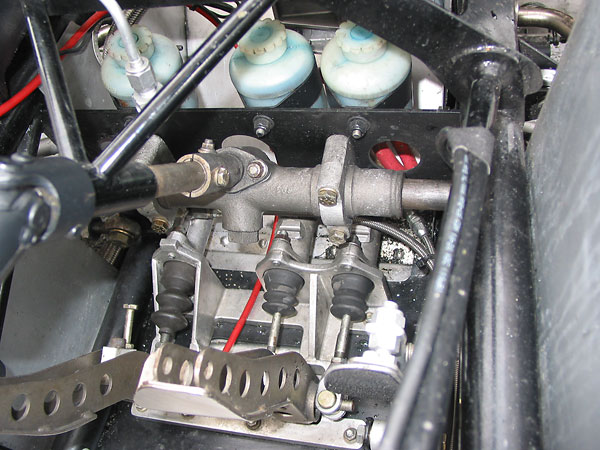
�
Cooper's own proprietary steering rack with cast magnesium housing.
�
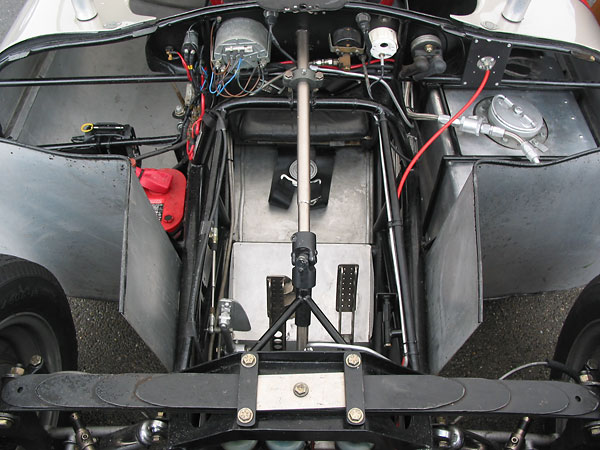
�
Steering shaft installation details.
�
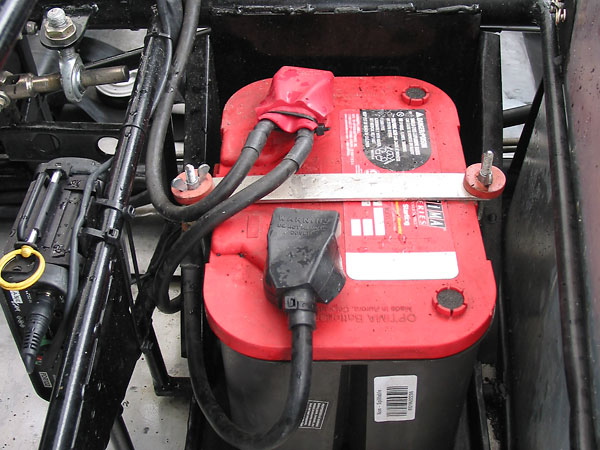
�
Optima "red top" battery.
�
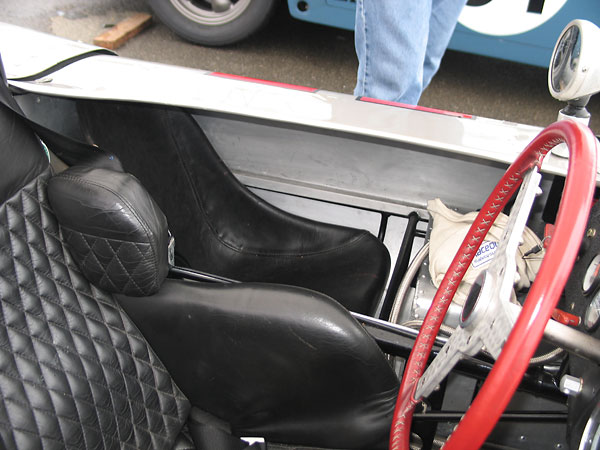
�
This strictly nominal passenger seat may have met the letter if not the spirit of 1955 sports
�
car class rules. Even if an adult torso might somehow squeeze under the bodywork, there's
�
no room at all for a head or legs. A fuel tank fills the space in front of the seat.
�
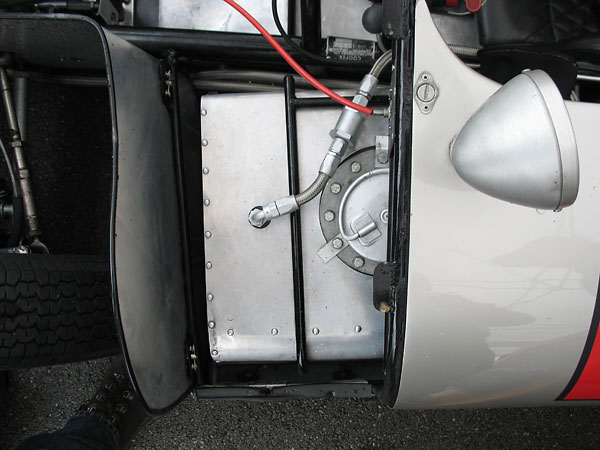
�
Authentic replica aluminum fuel tank, with safety bladder built in.
�
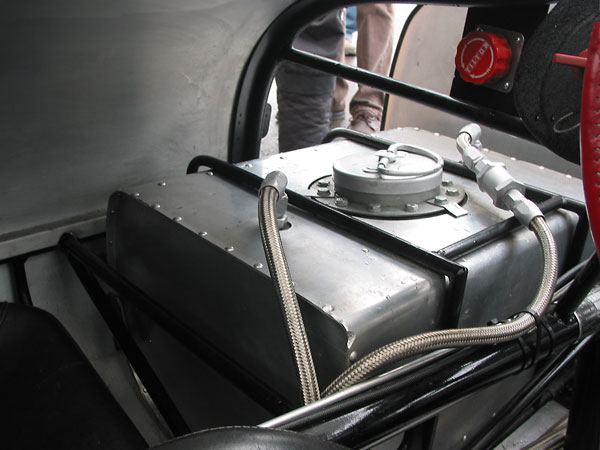
�
Tilton remote brake bias adjustor knob (mounted on lefthand side of dashboard.)
�
�
Exterior
��
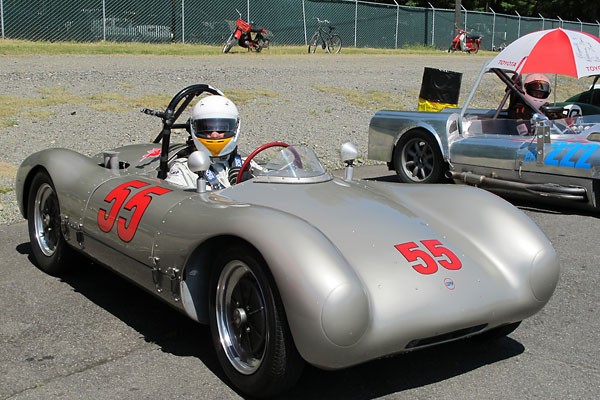
�
We're told that Porsche calls this paint color "linen silver metallic."
�
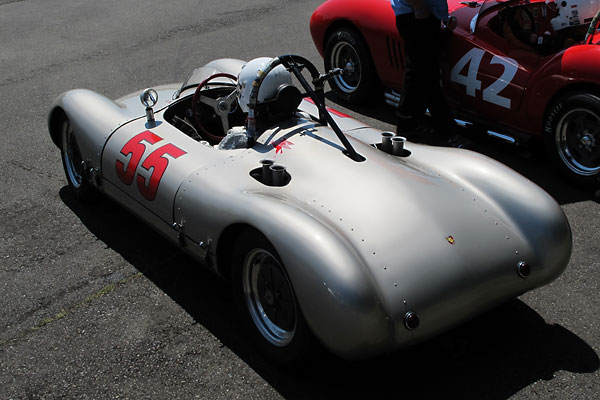
�
We went to the Pacific Northwest Historics at Pacific Raceways in Kent, Washington to get
�
photos of Cameron Healy's Cooper-Porsche on a bright sunny day!
�
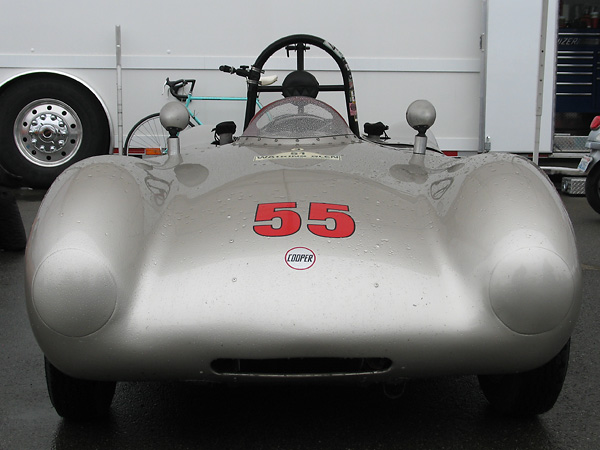
�
We had previously inspected the vintage Pooper during chilling rain at Watkins Glen.
�
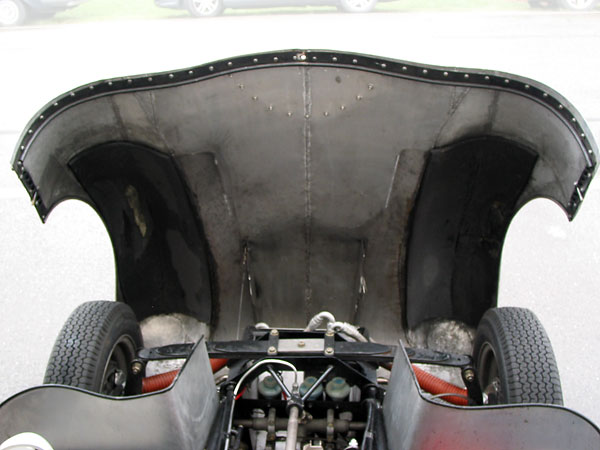
�
At some point in the car's history, its original working headlights went missing.
�
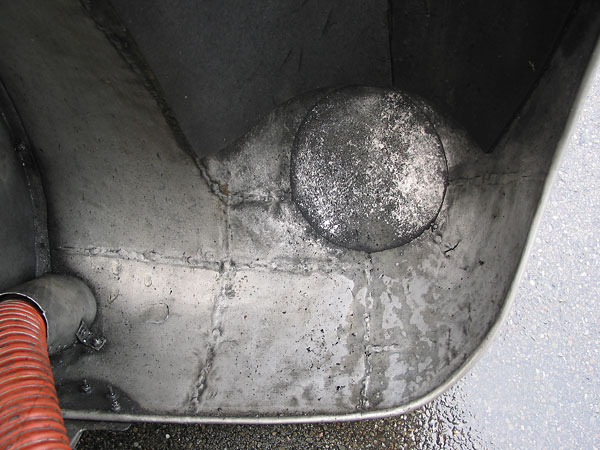
�
Welds are visible from the bottom side.
�
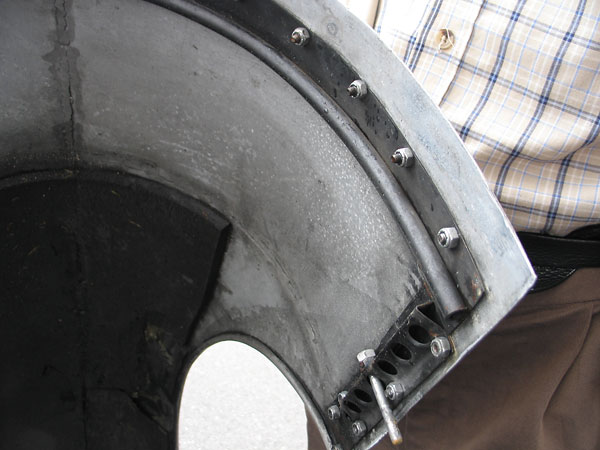
�
Bonnet reinforcements.
�
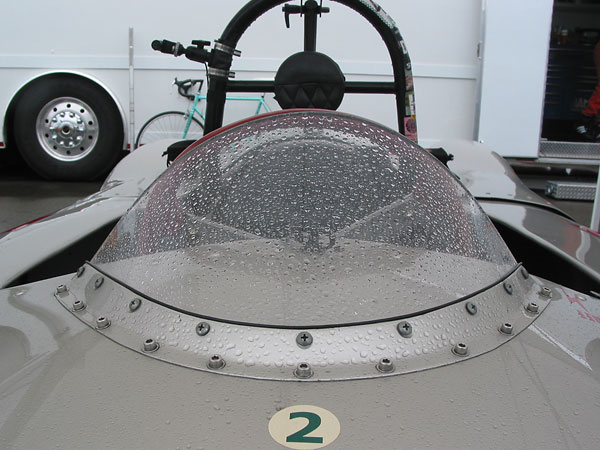
�
Perspex windscreen.
�
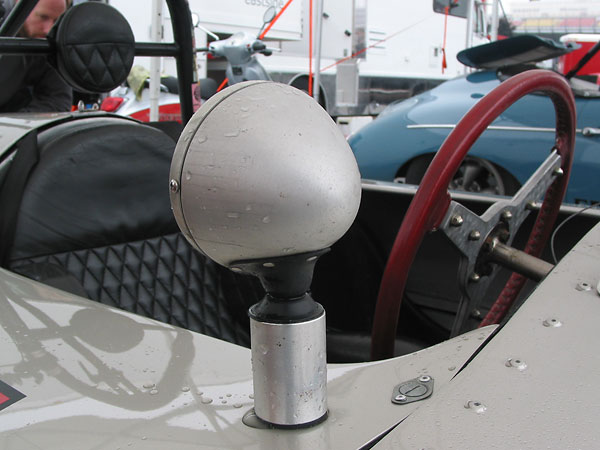
�
Steering wheel reinforcement.
�
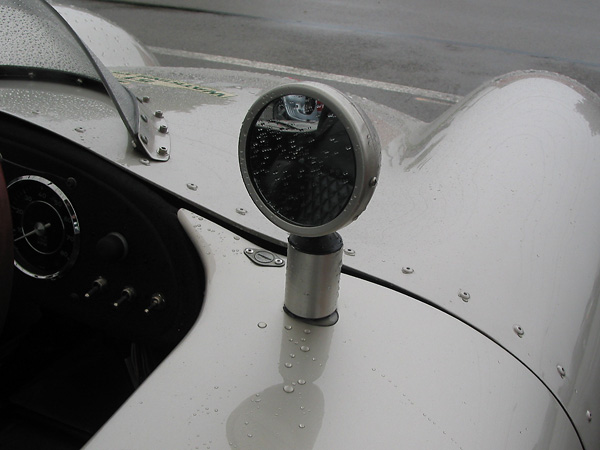
�
GT Classic mirror.
�
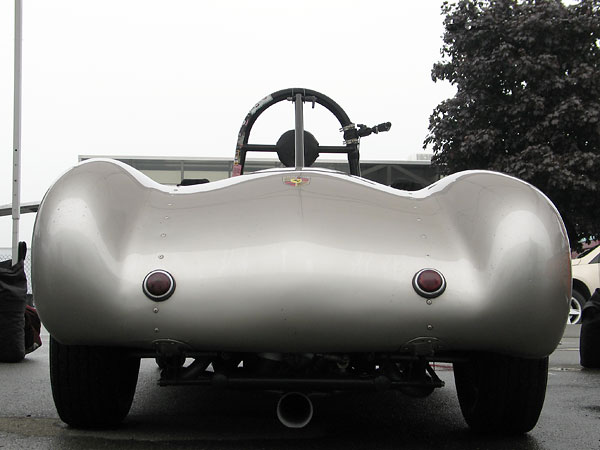
�
Single exhaust.
�
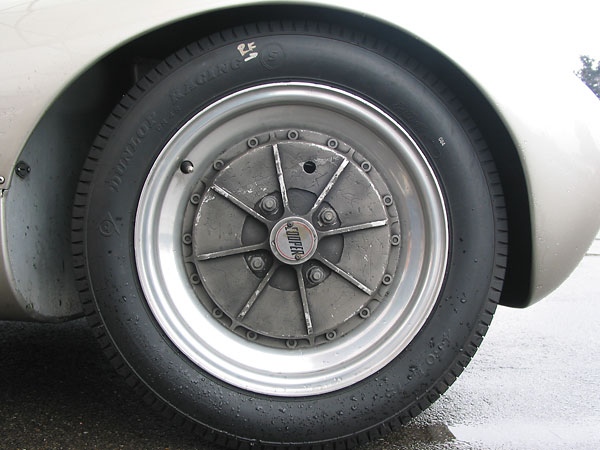
�
Hubless wheels bolted around the circumference of light alloy brake drums. (We believe
�
this design approach was pioneered on Issigonis' Lightweight Special, circa 1938).
�
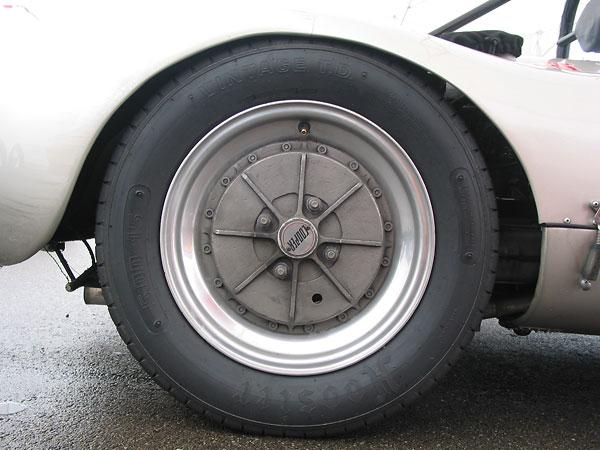
�
Dunlop Racing CR48 4.50L-15 (front) and Hoosier Vintage TD 5.00-15 (rear) tires.
�
�
All photos shown here are from September 2009 when we viewed this car at The US Vintage Grand �
Prix at Watkins Glen or from June 2011 when we viewed this car at The Pacific Northwest Historics�
at Pacific Raceways in Kent, Washington.�
All photos by Curtis Jacobson and Don Moyer for BritishRaceCar.com, copyright 2011. �
All rights reserved.
�
| If you liked this article, you'll probably also enjoy these: | �|||||
 | �
Dan Leonard '49 MG TC Special | �
 | �
Bob Millstein '51 XK-120 Special | �
 | �
Jay Nadelson '57 Cooper T43 | �
| You're invited to discuss anything you've seen here on The British Racecar Motorsports Forum! | �|||||
�
Notice: all the articles and almost all the photos on BritishRacecar.com are by Curtis Jacobson.
�
(Photos that aren't by Curtis are explicitly credited.) Reproduction without prior written permission is prohibited.
�
Contact us to purchase images or reproduction permission. Higher resolution images are optionally available.
�

 �
�